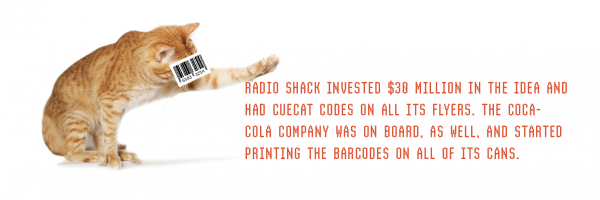Sometimes we get so caught up in what we’re doing, we forget why we’re doing it. The tech industry is especially susceptible to this. And the best way to prove it is with an example.
Cue … the CueCat.
In 2000, the CueCat was released by Digital Convergence Corporation (which is no longer in business). The CueCat was a barcode reader – of course shaped like a household feline – that connected to your desktop computer. Users of the product were supposed to use it to scan specially formatted barcodes that would direct them to specific webpages.
In the beginning, the CueCat took off. Marketers went nuts for it. Barcodes started appearing in many newspapers and magazines, in publications as notable as Wired and Forbes. Radio Shack invested $30 million in the idea and had CueCat codes on all its flyers. The Coca-Cola Company was on board, as well, and started printing the barcodes on all of its cans and bottles of soda.

Well, despite its initial popularity, the device was unanimously heralded as a complete failure. The $185-million investment was reportedly “a massive flop” and a “fiasco.” Aptly summed up by Jeff Salkowski, then writing for the Chicago Tribune: “You have to wonder about a business plan based on the notion that people want to interact with a soda can.”
That was 17 years ago. 12 years later, we apparently decided it was a good idea to give the whole thing a go again.
Enter … QR codes.
Despite actually being created two decades before the CueCat, the technology behind the QR code started to draw the eye of U.S. marketers in 2012. And once they saw it, oh boy did they eat it up. (Sound familiar?) QR codes were everywhere imaginable – flyers, websites, posters, billboards. They were even on van wraps and semi-trucks! (Honestly, who thought it was a good idea to put a QR code on a moving vehicle?!)
The problem was, as fate would have it, history indeed repeated itself. Like the CueCat, QR codes quickly fizzled out of popularity. It was yet another fad. And as marketers, we should have seen it coming.
George Santayana’s well-known aphorism comes to mind: “Those who cannot remember the past are condemned to repeat it.” Also Jeff Goldbloom’s line from Jurassic Park: “Your scientists were so preoccupied with whether or not they could, they didn’t stop to think if they should.”
So what’s the moral of the story here?
As marketers, let’s not be so quick to follow the rabbit down the hole. (And let’s face it, there are and will continue to be a lot of rabbits.) While we may be able to temporarily catch someone’s eye with a flashy gimmick, we have to accept that, chances are, it won’t last. Be smart. Spend your time and efforts focusing on your message and how to best reach your audience, rather than being distracted by that flashy gimmick.




